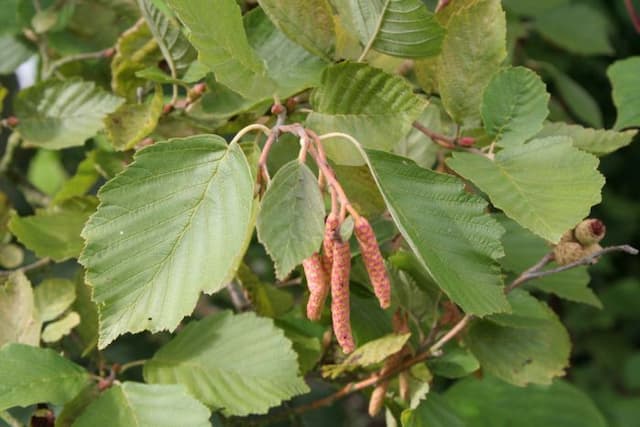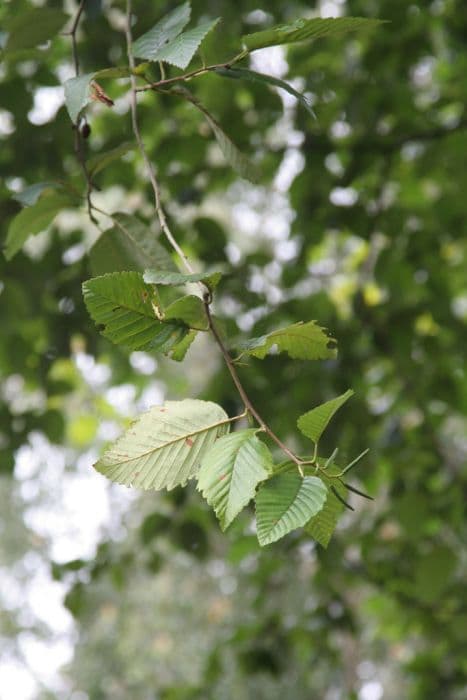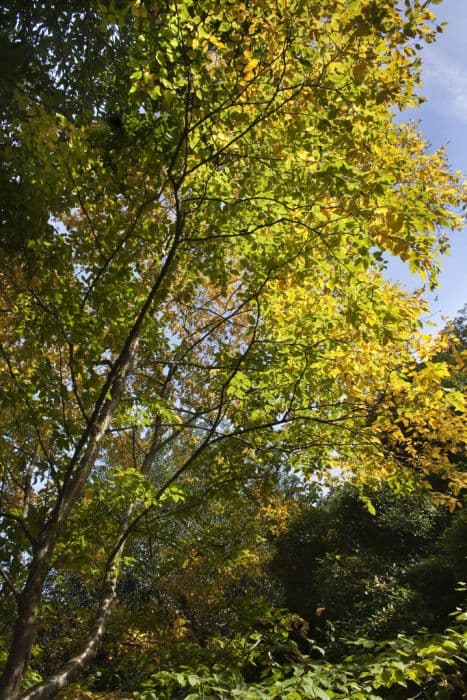Paper birch Betula papyrifera

ABOUT
The plant known as the paper birch is recognized by its distinct white bark that peels off in paper-like layers, an attribute that gives it its common name. The bark often has small horizontal markings, and as the tree ages, the bark can become more rugged at the base. Its leaves are green, oval to triangular in shape, and have a pointed tip with a serrated or toothed edge. In the fall, the foliage provides a splendid show, turning bright yellow before dropping. The paper birch produces both male and female flowers in separate catkins, with the males being longer and the females more upright and shorter. After flowering, the female catkins develop into small cones that contain numerous small winged seeds, which are dispersed by the wind. The plant has a slender form and its branches tend to be light and airy, providing a moderate amount of shade underneath.
About this plant
 Names
NamesFamily
Betulaceae.
Synonyms
Paper Birch, White Birch, Canoe Birch, American White Birch, Silver Birch, White Paper Birch.
Common names
Betula alba var. papyrifera, Betula commutata, Betula monticola, Betula papyracea, Betula papyrifera var. commutata, Betula papyrifera var. kenaica, Betula papyrifera var. monticola, Betula papyrifera var. subcordata.
 Toxicity
ToxicityTo humans
The Betula papyrifera, commonly known as the Paper Birch, is not typically toxic to humans. There are no well-documented cases of poisoning from ingesting parts of the Paper Birch. Therefore, there are no specific symptoms associated with poisoning from this plant to describe.
To pets
For pets, the Paper Birch is also not considered toxic. It is generally safe, and there are no known toxic effects reported for domestic animals ingesting this plant. Thus, there should be no specific symptoms of poisoning expected from pets consuming parts of the Paper Birch.
 Characteristics
CharacteristicsLife cycle
Perennials
Foliage type
Deciduous
Color of leaves
Green
Height
50 feet [15 meters]
Spread
35 feet [10.67 meters]
Plant type
Tree
Hardiness zones
2-6
Native area
North America
Benefits
 General Benefits
General Benefits- Ecosystem Support: Paper Birch provides food and habitat for various wildlife including deer, moose, and snowshoe hare.
- Ornamental Value: The tree is aesthetically pleasing due to its distinctive white bark, which peels off in paper-like layers.
- Shade Provider: It serves as a natural shade canopy in gardens and parks, which can reduce local temperatures and provide a cool resting area.
- Soil Stabilization: The root systems help to control erosion by stabilizing the soil.
- Water Conservation: The shade from these trees also helps minimize water evaporation from the surrounding soil.
- Seasonal Interest: Paper Birch offers year-round visual interest with its changing leaves, catkins in the spring, and notable bark in winter.
- Educational Resource: Its distinctive characteristics are useful for teaching about native tree species and different types of wood.
- Craft Material: The bark has been traditionally used by indigenous peoples for crafting items such as containers and canoes.
- Wildlife Attraction: Bird species, like sapsuckers, feed on the sap, while others utilize the tree for nesting.
 Medical Properties
Medical Properties- Anti-inflammatory: Betula papyrifera has been used in traditional medicine for its potential to reduce inflammation.
- Analgesic: The plant has been historically used to alleviate pain.
- Diuretic: It is believed to promote the production of urine which helps in flushing out toxins from the body.
- Antiseptic: The bark of Betula papyrifera might have antiseptic properties that can be beneficial for wound healing.
- Astringent: It has been used to tighten tissues and relieve irritation, which can be helpful in treating skin conditions.
 Air-purifying Qualities
Air-purifying QualitiesThis plant is not specifically known for air purifying qualities.
 Other Uses
Other Uses- The bark of the paper birch can be used as paper to write on, especially by Native Americans historically for communication and record-keeping.
- Canoe construction is one of the traditional uses of paper birch bark due to its large size, pliability, and waterproof qualities.
- Birch bark can be fashioned into baskets and containers, which indigenous peoples have utilized for collecting and storing items.
- The wood of the paper birch is suitable for woodworking, creating furniture, and carved objects because it is easily workable and has a pleasing grain.
- Birch sap can be tapped and used to make birch syrup, a less common alternative to maple syrup with a distinct flavor.
- The bark has been used as roofing material for makeshift shelters due to its flexibility and water-resistant nature.
- During emergencies, the thick bark can be used as a kindling for fires because it contains volatile oils that burn even when wet.
- The wood of the paper birch is excellent for producing high-quality paper and specialty items like paper for artwork due to its fine texture and printability.
- When peeled into thin layers, birch bark can serve as a natural wrapping material for food preservation, similar to using foil or plastic wrap.
- The tree's branches and twigs can be processed into wood chips that are used for landscaping and mulching gardens.
Interesting Facts
 Feng Shui
Feng ShuiThe Paper Birch is not used in Feng Shui practice.
 Zodiac Sign Compitability
Zodiac Sign CompitabilityThe Paper Birch is not used in astrology practice.
 Plant Symbolism
Plant Symbolism- Adaptability: The Paper Birch is known for its ability to thrive in various soil types and climates, symbolizing the capacity to adjust to different life situations and remain resilient.
- Purification: Paper Birch has traditionally been associated with purification and protection, commonly used in Native American ritual practices to ward off negative spirits.
- New Beginnings: The tree's tendency to shed its bark easily is seen as a metaphor for rebirth and renewal, representing a fresh start or a new chapter in life.
- Hope: As one of the first trees to grow back after a forest fire, the Paper Birch stands as a symbol of hope and regeneration in the wake of destruction or hardship.
 Water
WaterFor the Paper Birch, it is important to maintain a consistently moist soil environment, especially during the first few years after planting to ensure proper establishment. Young trees benefit from watering approximately once a week with about 10-15 gallons of water, depending on soil conditions and climate. Mature Paper Birches may require less frequent watering but should receive about 1 inch of water weekly from rainfall or irrigation. During dry spells or drought, increasing watering to twice a week can help prevent stress. Adjust the amount and frequency according to season and weather conditions, ensuring that the soil does not become waterlogged.
 Light
LightThe Paper Birch thrives best in full sunlight conditions but can also tolerate partial shade. Ideally, planting this tree in a location where it receives at least six hours of direct sunlight daily ensures robust growth. Avoid deeply shaded areas, which can lead to reduced vigor and poor form.
 Temperature
TemperaturePaper Birch trees are well-suited to cold climates and can tolerate a wide range of temperatures, thriving in areas where winter temperatures drop as low as -40°F and where summer temperatures seldom exceed 75°F. The ideal growing conditions for Paper Birch fall between 60°F and 70°F, which are typical temperatures of its native northern forests.
 Pruning
PruningPruning the Paper Birch should be done to remove dead or diseased branches, to encourage a strong structure, and to maintain the desired shape. The best time to prune is in late fall or winter when the tree is dormant to prevent the attraction of insects that can cause disease. Pruning should be done sparingly and never remove more than 25% of the crown at one time to avoid stressing the tree.
 Cleaning
CleaningNot needed
 Soil
SoilPaper birch thrives in a well-draining soil with a slightly acidic to neutral pH, ranging from 5.0 to 7.0. A mix of sandy loam soil with organic matter such as peat moss and compost will support its growth. Regular mulching can help maintain soil moisture and health.
 Repotting
RepottingPaper birch trees, being large and primarily outdoor trees, are not typically repotted. Instead, they are transplanted if necessary. Young trees may require relocation every few years until they establish.
 Humidity & Misting
Humidity & MistingPaper birch requires moderate to high humidity levels, mimicking its natural forested habitats. It can withstand a wide range of humidity conditions outdoors, but it thrives in environments where the humidity is consistently above 40%.
 Suitable locations
Suitable locationsIndoor
Paper birch isn't suitable for indoor growth due to size.
Outdoor
Plant in moist, well-drained soil; full to partial sun.
Hardiness zone
2-7 USDA
 Life cycle
Life cycleBetula papyrifera, commonly known as Paper Birch, starts its life as a seed that requires a period of cold stratification to germinate. Upon germinating in spring, the seedling grows rapidly, relying on nutrients stored in the seed. It enters the juvenile phase, developing a root system and a stem that begins to display the characteristic white, peeling bark as it matures. The Paper Birch reaches reproductive maturity after several years, producing catkins that release pollen and ovules; fertilization occurs, producing seeds dispersed by wind. As an adult tree, it continues to grow in height and girth, and it can live for up to 140 years. Throughout its life, the Paper Birch undergoes seasonal changes, with leaves that turn yellow in the fall and are shed before winter dormancy.
 Propogation
PropogationPropogation time
Late winter to early spring
The most popular method of propagating the Paper Birch (Betula papyrifera) is by seed. Best done in fall or winter, seeds should be sown outdoors in beds or pots. After collection, the seeds can be stratified—a process mimicking natural winter conditions—by placing them in a sealed container with moist sand or peat and refrigerating for 60-90 days, which is approximately equal to 2-3 months. Once stratified, seeds are sown on the surface of a well-drained seed starting mix and lightly covered with soil. They need abundant light to germinate, so placement in a bright location is imperative. Germination typically occurs in the spring as temperatures rise, and once seedlings are strong enough, they can be transplanted to their permanent location, usually within a few months after sprouting.









